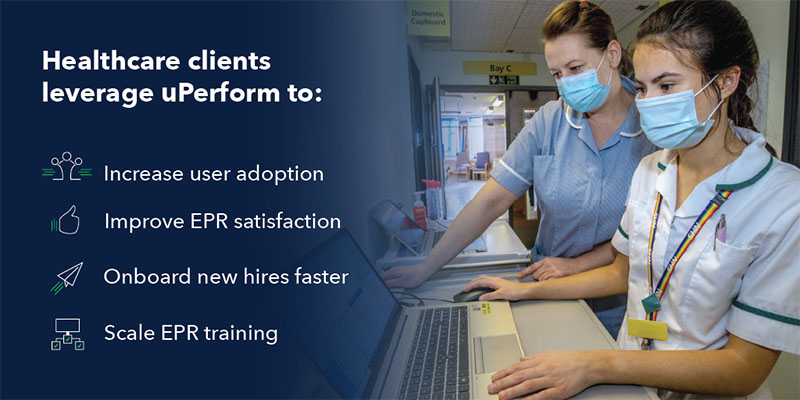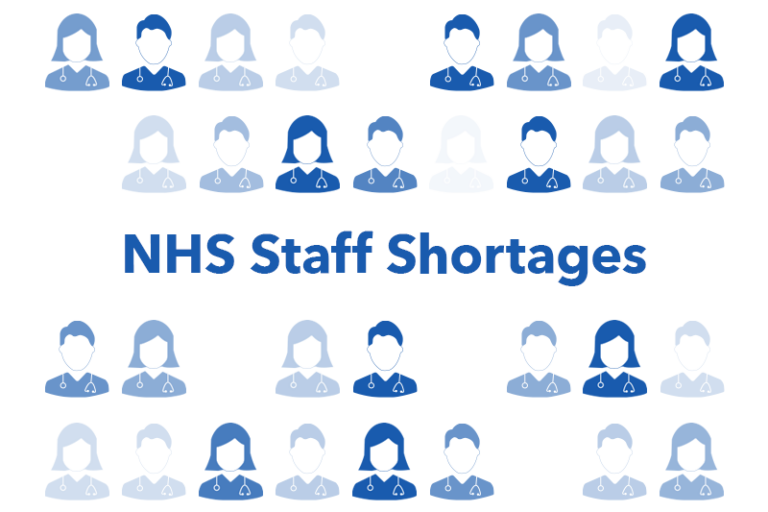As part of the U.K.’s digital transformation mandate, many NHS trusts are preparing for, or have already completed, their first EPR implementation. The EPR is a valuable tool for improving clinician efficiency and patient care. However, it is up to NHS trusts to drive that value with a successful implementation and a plan for post-implementation support.
Studies show that 66% of the variation in EPR usability rests on the provider, not the EPR itself. Regardless of how good an EPR might be, it won’t be effective in improving patient care and safety if clinicians don’t receive proper training and support in their use of the tool. Even worse, lack of adequate EPR training can lead to low EPR satisfaction and even clinician burnout.
Using traditional methods to deliver training is becoming more challenging for health trusts. The increasing complexity of EPRs and healthcare tech paired with rising turnover is putting a strain on training teams and resources.
NHS trusts looking to get the most out of their EPR may want to consider a just-in-time training solution. It helps better equip trusts to scale onboarding, support doctor rotation and enable ongoing training and support for clinical staff through change updates and new go-lives.
What is just-in-time training?
Just-in-time training aims to solve many of the challenges associated with traditional training by delivering learning content to clinicians at their time of need. Traditional classroom training is costly and difficult for health systems to scale. It also results in low retention, as clinicians forget much of what they’ve learned as soon as they leave the classroom.
With just-in-time training, clinicians have 24/7 access to microlearning content when and where they need it – in their workflow. With help available whenever they need it, clinicians can brush up on old or infrequently used skills and learn new workflow changes, all while spending less time in training.
How to onboard clinicians with a just-in-time training platform
Clinician success with the EPR begins with onboarding. According to KLAS Research, initial training and onboarding are some of the most important determinants of EPR satisfaction, followed closely by ongoing training. While a just-in-time training model can support clinicians while they work, it is still necessary to provide adequate onboarding for new hires. A just-in-time training model, however, can help reduce the time spent in initial training and help trusts keep up with provider turnover and onboarding needs.
With just-in-time training, onboarding materials can be delivered to new hires based on their role and workflow. Clinicians can work through the onboarding materials at their own pace. For experienced clinicians, this means they can complete training faster, spending less time on training content that they are more familiar with or that may not be relevant to them. For less experienced clinicians, they can take the time to absorb new information or even revisit learning content as necessary.
A just-in-time training strategy may focus less on walking new hires through complex workflows and instead focus on providing new hires with the basic information they need to get started in their new role. At the very least, onboarding should cover the basics of how to login and navigate the EPR and ensure that clinicians know where to go for additional help once they are on the floor. Once clinicians have a solid foundation, just-in-time training materials can support them in their day-to-day.
Delivering ongoing support with a just-in-time training platform
Once clinicians are through initial onboarding, a just-in-time training platform provides 24/7 access to support while they work. It excels in delivering bit-sized, microlearning in the form of tip sheets, videos and interactive simulations. Just-in-time ongoing training provides many benefits for trusts and providers, including:
Better retention with contextual learning: Recent KLAS Research data suggests that clinicians learn best when training is delivered within the context of patient care. Just-in-time training delivers learning opportunities to providers in their workflow while they’re caring for patients, helping to reinforce new skills and integrate them into their normal workflow.
Improved efficiency with improved access to support: A just-in-time training model provides users with 24/7 access to support. With support available in their workflow, users access the support they need to complete the task at hand and get back to patient care faster.
Greater scalability with self-paced learning format: Ongoing training is vital to provider success, but many trusts struggle to get clinicians to attend additional training sessions. Between limited instructor availability and classroom space and providers having little time to spend away from patients, it can be difficult to scale classroom training. Just-in-time training is easily scalable, as providers access learning materials on their own time. This can also free up training staff to provide more opportunities for one-on-one coaching or at-the-elbow support.
Stabilising and optimising the EPR with just-in-time learning
Looking for a way to ensure the success of your EPR implementation and its continued use? uPerform is a just-in-time training and support platform that integrates with leading EPRs to deliver training directly in the workflow. We work with leading health systems around the world to maximise their EPR investment. Here’s how some of our clients are moving the needle on EPR training and efficiency:

Improving EPR satisfaction: Users of uPerform at Baylor Scott & White Health rate their EPR satisfaction 12.9 points higher than non-users. With support materials available in their flow of work, users are more satisfied with the EPR itself and the training they receive, key metrics in reducing clinician burnout and turnover.
Onboarding new hires faster: New hires at UCHealth used to spend 8 hours in the classroom before gaining access to Epic. Now, since leveraging uPerform to deliver initial onboarding, new hires can gain access to Epic and start seeing patients in as little as 3 hours.
Scaling EPR training: Whether it’s organisational growth, mergers or rising turnover, many health organisations are facing an increased demand for onboarding. When Gundersen was faced with all three, they turned to uPerform to help scale their training program. Tune into this podcast to hear how they were able to accelerate onboarding and scale training to keep pace with both organisational growth and increased turnover.
Related Articles
Discover if uPerform is right for you
Contact us today to schedule a uPerform demo. Learn how uPerform works with your specific EPR and gain training tips and insights based on our extensive experience with healthcare clients. We look forward to speaking with you!





